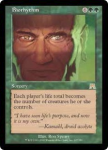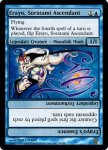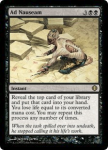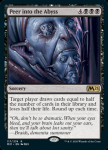Oversoul
The Tentacled One
Recently, the Commander Rules Committee completed a project in which their website was updated to provide brief explanations for all of the cards on the ban list. The results of the project look pretty nice, and I'm sure that the new blurbs would be informative for new players or those curious about the format. For my part, I first stumbled across the ban list back when it was a "suggested ban list" on their old website, back in 2008 or so. Since then, I've shifted from not playing EDH at all or only vaguely maintaining a single EDH deck to playing EDH every week and maintaining an arsenal of 8 to 10 decks. But across the past 16 years, I've pretty much always been severely critical of the ban list.
In the past, explanations by the RC for various ban decisions were mostly buried in internet archives of their defunct message board, as well as strewn sporadically across other Magic content websites, such as Star City Games. This new approach is far superior. Seeing the elegance of everything consolidated in one place, I am inspired to do the same. If I'm going to blather on about the EDH ban list, there might as well be a thread specifically for that.
It looks like the list, ignoring the three categorical bans at the top (for ante cards, conspiracy cards, and victims of the June 10th, 2020 massacre), there are 45 cards on the list. Since the blurbs for the original five Moxen are presuably identical, I figure I'll take the next 41 days to respond to each blurb, one at a time, providing my own commentary. Some of that commentary is likely going to be pretty critical, but some of it will likely be rather positive as well.
Feel free to add your own commentary as well, whether that's in response to the official RC blurbs or to the drivel I write in response. Before I begin with the individual banned cards, it's best to review the current Format Philosophy Document.
So that's the Philosophy. Now on with the ban list!
In the past, explanations by the RC for various ban decisions were mostly buried in internet archives of their defunct message board, as well as strewn sporadically across other Magic content websites, such as Star City Games. This new approach is far superior. Seeing the elegance of everything consolidated in one place, I am inspired to do the same. If I'm going to blather on about the EDH ban list, there might as well be a thread specifically for that.
It looks like the list, ignoring the three categorical bans at the top (for ante cards, conspiracy cards, and victims of the June 10th, 2020 massacre), there are 45 cards on the list. Since the blurbs for the original five Moxen are presuably identical, I figure I'll take the next 41 days to respond to each blurb, one at a time, providing my own commentary. Some of that commentary is likely going to be pretty critical, but some of it will likely be rather positive as well.
Feel free to add your own commentary as well, whether that's in response to the official RC blurbs or to the drivel I write in response. Before I begin with the individual banned cards, it's best to review the current Format Philosophy Document.
As someone who has recently played a fair bit of PreDH, there's a stark contrast between what the format used to look like when this Philosophy Document was originally conceived and the way that Commander is now played. It's a living format, so some degree of that is to be expected, but the departure is so pronounced that it can't go without mention. Is this WotC's fault and not something the RC can really do much about? Probably. But it's interesting, and strikes me as at least slightly dubious, that even though the format looks completely alien to the form it took a decade or so ago, the ban list looks pretty much the same.Commander RC said:Commander is for fun. It’s a socially interactive, multiplayer Magic: the Gathering format full of wild interactions and epic plays, specifically designed as an alternative to tournament Magic. As is fitting for a format in which you choose an avatar to lead your forces into battle, Commander focuses on a resonant experience.
Nice.Each game is a journey the players share, relying on a social contract in which each player is considerate of the experiences of everyone involved–this promotes player interaction, inter-game variance, a variety of play styles, and a positive communal atmosphere. At the end of an ideal Commander game, someone will have won, but all participants will have had the opportunity to express themselves through their deck building and game play.
They did once. I've seen that when I've piloted my PreDH decks against other PreDH decks, or even when I've played some of my goofier theme decks against new and clueless players. But these days, even the officially released precons are often so oppressive that I, as a player with decades of experience and access to pretty much whatever cards I want to play, can't afford to try "participation and expression."The rules of Commander are designed to maximize these experiences within a game of Magic. The addition of a commander, larger life total, and deck building restrictions emphasize the format’s flavor; they increase deck variance and add more opportunities for participation and expression.
This is an important distinction between the EDH ban list and ban lists for most other formats. Some have argued that this philosophy for a ban list is not really tenable, and they may be right. I have mixed feelings on the matter.The goal of the ban list is similar; it does not seek to regulate competitive play or power level, which are decisions best left to individual play groups.
We'll come to some individual examples later, but I contend that given this statement (emphasis theirs, by the way), cards that demonstrably don't exhibit these issues do not belong on the ban list. In other words, if a banned card wouldn't be extremely consistent, ubiquitous, or restrictive, then it should be unbanned, according to the very philosophy that the RC purport to be relying on.The ban list seeks to demonstrate which cards threaten the positive player experience at the core of the format or prevent players from reasonable self-expression. The primary focus of the list is on cards which are problematic because of their extreme consistency, ubiquity, and/or ability to restrict others’ opportunities.
The thing I don't like about this section of the document is that it is formated to look very thorough and detailed, but is actually so vague that it might as well be saying nothing at all.No single rule can establish criteria for a ban; there are many mitigating or exacerbating factors. Some cards will represent an extreme on a single axis; others are a confluence of multiple smaller issues. The following list isn’t exhaustive, nor is it a checklist, but it represents ways in which cards challenge the positive experiences players look for in commander games. It includes cards which easily or excessively
• Cause severe resource imbalances
• Allow players to win out of nowhere
• Prevent players from contributing to the game in a meaningful way.
• Cause other players to feel they must play certain cards, even though they are also problematic.
• Are very difficult for other players to interact with, especially if doing so requires dedicated, narrow responses when deck-building.
• Interact poorly with the multiplayer nature of the format or the specific rules of Commander.
• Lead to repetitive game play.
Cards which are banned likely meet a few of these criteria in a significant way; not all cards which meet some of the criteria need to banned.
The reasoning provided applies to bans, but not unbans. Emotional attachment to a deck, personalization, bonds, etc. are not affected by unbans.We prefer to be conservative with what goes on or comes off the ban list. Commander players often become emotionally attached to their decks through play and personalization, and we value that experience highly. We only want to disrupt that bond when necessary.
I actually like this bit of the Document, but am a bit annoyed with the way it's been misapplied by other parties. Much of the EDH content on the internet uses this "Rule Zero" to promote the idea that everyone should be having some sort of chat session before every game, so that all of the players will be have a shared understanding of expectations for the game that is about to commence. In practice, if one has a regular playgroup of friends who know each other, this concept can be streamlined to well that it works. For a bunch of strangers at a local game store, attempts at this "Rule Zero Conversation" are inevitably awkward and boring.Commander is designed to be a malleable format. We encourage groups to use the rules and the ban list as a baseline to optimize their own experience. This is not license for an individual to force their vision onto a play group, but encouragement for players to discuss their goals and how the rules might be adjusted to suit those goals.
I joined that Discord, but I almost always forget that it exists, so I'm not really active over there. However, the rest of you don't need to follow my bad example. The Discord is well worth checking out if you're interested in the format.The format can be broken; we believe games are more fun if you don’t.
There’s a channel for discussing the format philosophy over on the RC Discord server. We look forward to you joining us.
You can also jump right to the Commander Rules page from here.
So that's the Philosophy. Now on with the ban list!
Last edited:






















